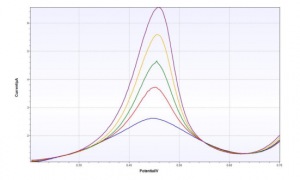Introduction
Pollution is a known issue for decades. A focus of interest is, of course, unhealthy, or outright toxic substances in resources we use for creating everyday goods or even consume ourselves. Spoiled water and food are the cause of many illnesses and other health issues. Due to this the monitoring of drinking water and food is an important task to keep people healthy. Mining releases heavy metals into the food chain. A sad fact is that the consequences of mercury pollution could be observed due to careless disposal of mining waste into rivers supplying villages with water.
This application note is intended to provide the user with a comprehensive set of instructions for use of the screen printed electrode (SPE) for determine Hg concentrations of aqueous solutions.
The demonstrated technique works also for other heavy metals if they deposit properly on gold surfaces or form gold alloys. The detection of heavy metals that have very similar redox potentials will lead to overlapping peaks and thus will make an accurate analysis very difficult.
Experimental
- Reagents: 6 M HCl, Hg(CH3COO)2 (standard solution or solid), 0.5 M H2SO4
- Equipment: PalmSens or EmStat with PSTrace software, Stirrer switch box
- Sensors: ItalSens IS-Au sensors , Simple cell or ItalSens flow through cell
Results
Perform SWV with the parameters from the file Hg detection [1]. This analysis will be performed with the standard addition method. Repeat the measurement after each standard addition. An example for the sample measurement showed in figure 1.


Figure 1. raw data of a series of standard additions including sample (red) and background (blue) measurement.
In reference [1] the LOD of this analysis was reported as <1ppb in the range of 0 to 100 ppb.
The electrode can be repeatedly taken out and the sample changed without any effect on the electrode performance. Care must be taken not to take out the sensor from the connector since the alignment of the contacts of sensor and holder have an impact. To store overnight, store dry but repeat the conditioning steps.
References
[1] Laschi, S.; Mascini, Palchetti, I.; M.; Gold-based screen-printed sensor for detection of trace lead; Sensors Actuat B-Chem 114, 2006, 460-465; DOI: 10.1016/j.snb.2005.05.028
[2] PalmSens application note, Quantification of mercury in aqueous solutions, May 27, 2015, www.palmsens.com


